Grass Seeds – Stay Safe Playing Out in the Grass

Grass seed season has begun – but what are grass seeds?
Grass seeds are small seeds that are shaped like a pointy grain of rice that have an ability to burrow into your dog’s skin. This can often result in painful swellings, irritation, painful ears, and infections. Spring and early summer brings lovely long grass to play in, but make sure you know what to look out for if your dog gets a pesky grass seed.
Where should I check my dog for grass seeds?
The grass seeds can burrow between the toes or under the paws into the webs, into ears, or even in the eye!
How can I check if my dog has a grass seed?
After walks, make sure you have a look at all your dog’s paws, particularly if you have a dog with thick or curly fur. They can be lodged right up between the toes so make sure you catch them before they burrow into the skin. If they’ve already burrowed, you might find that your dog has a painful swelling around the toes that they are constantly nibbling. If your dog is prone to collecting grass seeds, make sure you get the groomer to cut the fur short between and under the toes to make checking easier for you. If your dog suddenly starts shaking their head, scratching an ear, chewing a paw, or seems distressed after a walk, get them to your vet. The seeds are great at getting caught in ear fur, burrowing their way deep into the canal, or causing painful red swellings on the paws. These will need to be removed carefully by your vet. If your dog is distressed, a sedation will be recommended to ensure minimal stress for your pet, and to successfully remove the seeds safely.
Big hugs to all our OMNI pups, wishing you all a safe, and grass seed free summer.







 85 Great Portland Street, 1st Floor, London, W1W 7LT United Kingdom
85 Great Portland Street, 1st Floor, London, W1W 7LT United Kingdom





